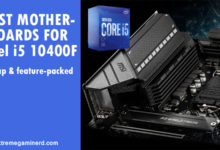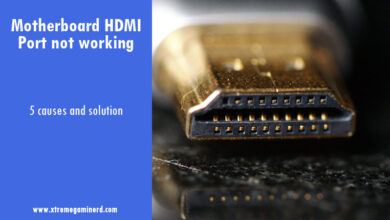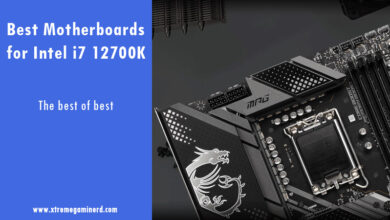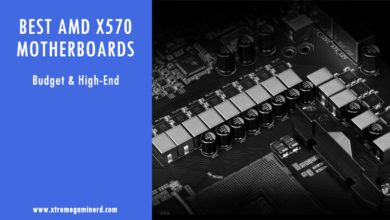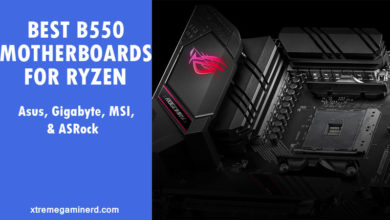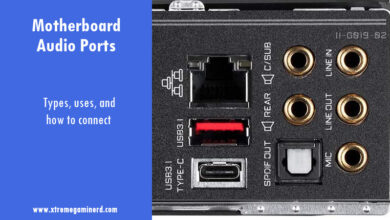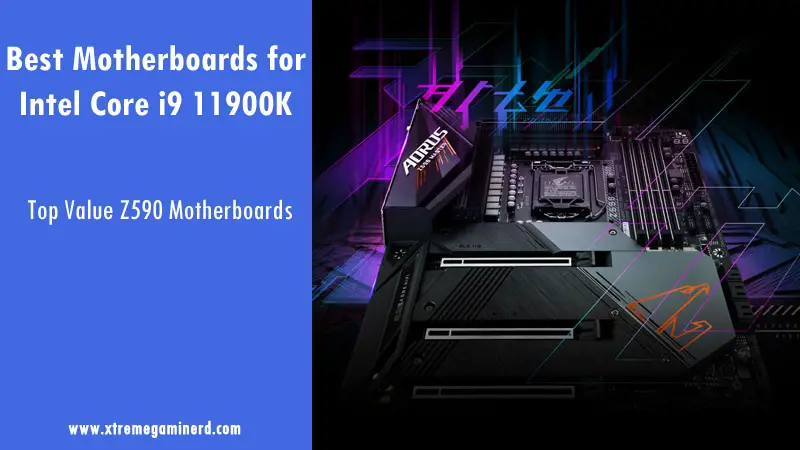
Featuring 8 cores and 16 threads, the Core i9 11900K is the latest high-end chip from Intel that needs a powerful motherboard for overclocking. While the processor is certainly a downgrade from the 10900K, it can provide similar performance in gaming. While in productivity I can’t recommend it at all due to its reduced cores/threads and high pricing.
With that said, the i9 11900K being the flagship processor in the Rocket Lake series, requires a motherboard that can handle the overclocking load without hitting the critical temperatures. The better the VRM and its components are, the better you will be able to sustain stable performance numbers.
For this chip, I strictly recommend going with a Z590 motherboard as you will get stronger VRMs in the enthusiast motherboards segment and better compatibility with the components through the chipset.
Following are the top choices to go with that will provide better thermals and stable overclocking during long durations.
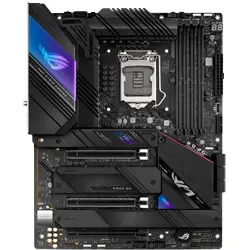
Specifications
- VRM: 14+2 Power Stages
- Memory: 128GB DDR4, 5333MHz
- Expansion Slots: 3x PCI-E x16
- Storage: 6x SATA, 4x M.2
- I/O: Total USB ports- 10, 2×2 Tri-Band Intel WiFi, 2x 2.5G LAN, 5x Audio jacks, Bios Flashback
Summary
Asus’s ROG series features an eminent personality in its products lineup whether graphics cards or motherboards. The Z590-E Strix Gaming Wifi is targeted towards those who want a premium look with performance that won’t be compromised.
With a powerful 16 power phase VRM and joint big heatsinks over the VRM, it can control the temperature very well. As i9 11900K generates a lot of heat, a strong VRM is essential and the better the heatsinks are, the stable will be the clock speeds.
For connectivity, it is on another level with 10x USB ports that include 2x Type C ports and has 2x 2.5G Ethernet ports for wired internet connections. Or if you want to connect to the internet wirelessly, then you can use the 2×2 Tri-Band Intel WiFi that can support very high internet data transfer speeds.
Moreover, you will get a Q-Code display onboard for detecting the cause of malfunctions which is very helpful in trial and error while overclocking. For cooling, you will have 8x fan headers in total including the pump, AIO and CPU fan making the cooling of your system easier.
The price of this board is $380 which is definitely not cheap but the features are worth it if the chip to be used is i9 11900K.
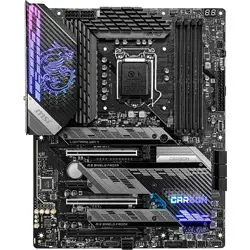
Specifications
- VRM: 16+1+1 Power Stages
- Memory: 128GB DDR4, 5333MHz
- Expansion Slots: 3x PCI-E x16
- Storage: 6x SATA, 4x M.2
- I/O: Total USB ports- 10, Intel Wifi 6, 2.5G LAN, 5x Audio jacks, Bios Flashback
Summary
MSI has a lot of great Z590 motherboards and for the i9 11900K, Z590 Carbon Wifi is perfect with 16+1+1 power phases where each power stage is rated at 75A totalling 1350A. This is somewhat close to the Maximus XIII Hero but for $150 less.
It has 3x PCI-E x16 slots, 2x PCI-E x1 slots for expansion cards and for storage, it has 3x M.2 connectors and 6x SATA ports that support RAID technology. For your chassis front panel, it features a Type C header that supports up to 10Gbps of speed and comes in handy for fast transfers.
At the I/O, it has a total of 10x USB ports where four are USB 2.0, two are USB 3.2 Gen 1, three are USB 3.2 Gen 2 with transfer speed up to 10Gbps and one USB 3.2 Gen 2×2 Type C that supports up to 20Gbps transfer speed.
Other connectivity features include Intel Wifi 6 adapter and a single Intel 2.5G LAN that are common on most Z590 motherboards.
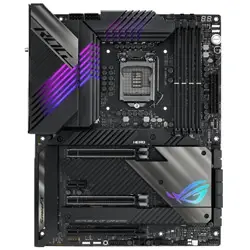
Specifications
- VRM: 14+2 Power Stages
- Memory: 128GB DDR4, 5333MHz
- Expansion Slots: 3x PCI-E x16, 1x PCI-E x1
- Storage: 6x SATA, 4x M.2
- I/O: Total USB ports- 10, 2×2 Tri-Band Intel WiFi, 2.5G LAN, 5x Audio jacks, Bios Flashback, Clear CMOS
Summary
While the Maximus XIII Hero features a 16 power phase VRM, the components are way better than that on the Z590E Gaming Wifi. Unlike most motherboards, it features power stages that are rated to handle 90Amps each totalling in 1440Amps of current support. This is one of the highest current support you will find on enthusiast Z590 boards.
It has a very premium design that features RGB lighting on the chipset and even on the VRM heatsinks extending from the I/O cover. For expansion cards, there are a total of 3x PCI-E x16 slots that support Nvidia SLI and for storage, it boasts 4x M.2 connectors along with 6x SATA ports. Make sure you read documentation of Asus on how the PCI-E slots share bandwidth with the SATA ports before you fill out every port/slot.
At the I/O, you will find a similar look to the Asus Z590-E Gaming Wifi with 10x USB ports, dual 2.5G Ethernet ports and 2×2 Tri-Band Intel WiFi for peripherals connectivity and Internet respectively. While the Z590-E is somewhat identical to this board in many areas, it lacks the onboard troubleshooting features the Maximus XIII Hero has.
It comes with a Q-Code display, FlexKey button, Re-try button, and Start button that are essential for enthusiast overclockers. While the cost of this board is $500, you can expect it to deliver the value expected for this price.
Feature-Rich
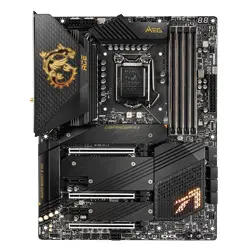
Specifications
- VRM: 16+2+1 Power Stages
- Memory: 128GB DDR4, 5600MHz
- Expansion Slots: 3x PCI-E x16, 2x PCI-E x1
- Storage: 6x SATA, 4x M.2
- I/O: Total USB ports- 10, Intel WiFi 6, 2.5G LAN, 5x Audio jacks, Bios Flashback, Clear CMOS
Summary
While most motherboards simply bring Type C ports at the I/O with up to 20Gbps of transfer speed which is definitely great, the MEG Z590 ACE brings 2x Thunderbolt Type C ports that support transfer speed of up to a whopping 40Gbps. Along with these, you will get 8x USB ports more that mostly include USB Gen 3.2 Gen 1 and Gen 2.
At the top, there is a powerful VRM being employed for taking care of any monster processor. Thanks to the 16+2+1 power stage VRM, you can overclock as much as you like with the help of a decent CPU cooler. I am pretty sure this is more than enough for the i9 11900K as it features aluminium heatsinks on the VRM with an embedded heat pipe that helps to cool down the power chokes of this beasty VRM.
Each of these phases can support up to 90A of current just like we have on the ROG Strix Z590 Maximus XIII Hero. For expansion cards, it has triple PCI-E x16 slots and 2x PCI-E x1 slots where the graphics card slots use Steel Armor for more strength to support heavier graphics cards.
For storage, it has 4x M.2 connectors and 6x SATA ports that are the best you can get on a Z590 motherboard. Moreover, the memory support is outstanding with support of up to 5600MHz that is hard to find. All of these features are available for $500 that I believe is decent and should be the #1 option for not only i9 11900K but also i7 11700K that also features 8 cores/16 threads.
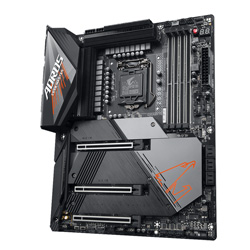
Specifications
- VRM: 18+1 Power Stages
- Memory: 128GB DDR4, 5400MHz
- Expansion Slots: 3x PCI-E x16
- Storage: 6x SATA, 3x M.2
- I/O: Total USB ports- 10, Intel WiFi 6, 2.5G LAN, 5x Audio jacks, Bios Flashback, Clear CMOS
Summary
Except for the high-memory clock support, PCI-E x1 slots and Thunderbolt USB Type C ports, the Z590 Aorus Master is almost as powerful as the MEG Z590 ACE. It has 18+1 power phases where the 18 power phases use doublers for achieving better stability in overclocking. Here too, each of the phases are rated to handle up to 90A of current.
On top of the VRM, you will find fins array aluminium heatsinks that are way better than the traditional VRM heatsinks that are most common on motherboards. Below the socket, there are 3x PCI-E x16 slots that use Steel Armor and have heatsinks installed on all the M.2 connectors.
Furthermore, the motherboard possess RGB LEDs on the I/O cover and chipset that are controllable via Gigabyte Fusion software which I personally use on my X370 Gaming 5 board. It’s not the best but it’s easy to use.
For updating the Bios, you can use the Q-Flash BIOS flashback button at the I/O and you can also reset it with the use of Clear_CMOS button that quickens the troubleshooting without opening up your chassis. For connectivity, there are 10x USB ports, Intel Wifi 6 adapter for wireless internet connection and a 2.5G LAN for wired connection.
As compared to the MEG Z590 ACE, it is a little behind in some features as mentioned above but the price is $100 lower which makes it a deal breaker for many users.
Final Words
First of all I don’t recommend going with the Intel Core i9 11900K. It’s simply one of the worst launches of Intel this year but if you are a die-hard Intel fan, and have made your mind then the above-mentioned boards will be perfect to combine with it where almost every board is available for under $500.
It’s not that i9 11900K is a complete crap as it is very much similar to any other high-end gaming CPU from previous gen and also competes with AMD’s 5000 series processors. The drawback is the reduced 2 cores/ 4 threads while the price is increased about $100 over the more powerful i9 10900K.
Let me know if you are going to get this processor for your PC build.

